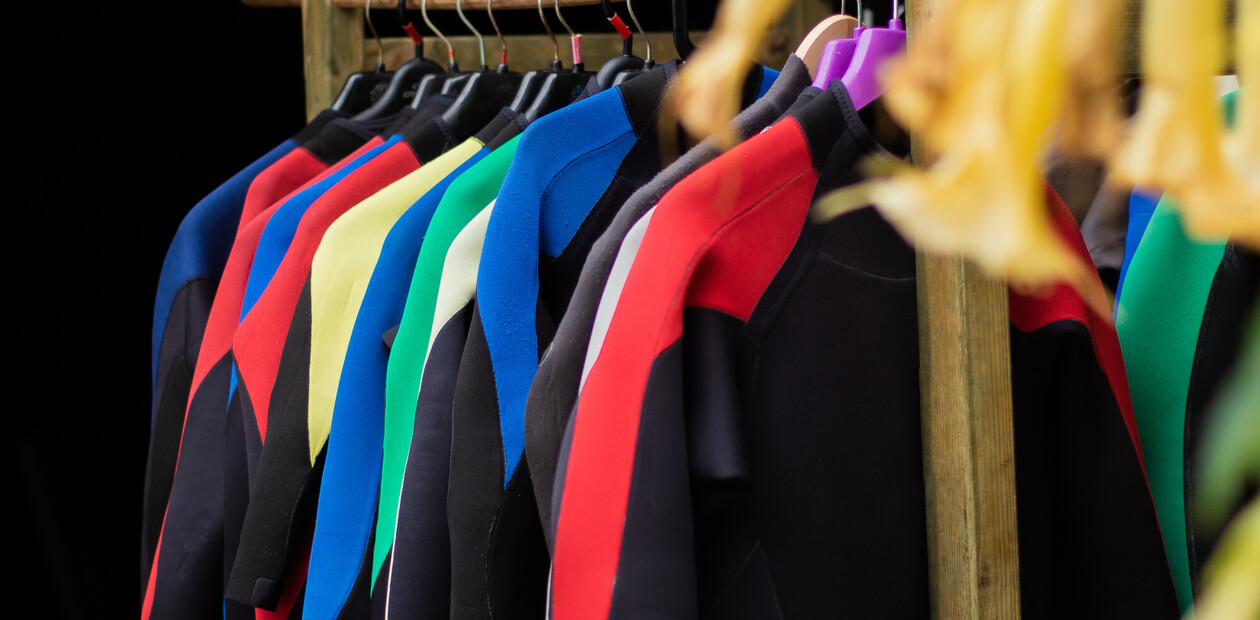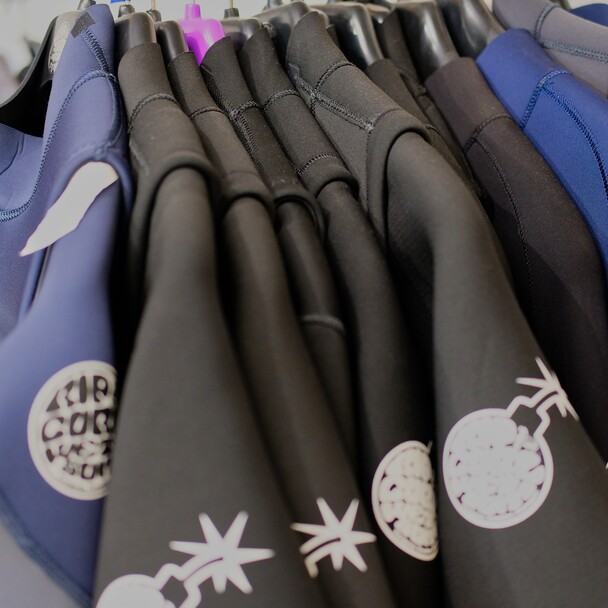Washing a wetsuit - How to care for your wetsuit properly
In the 1950s, Jack O'Neill, inventor of the wetsuit for surfers, thought: "I just want to surf longer in cold water". Yes, we want that too! So here are a few tips from us on how to wash and care for your wetsuit properly to get the most out of it for as long as possible.

- In a nutshell: Washing a wetsuit
- Why is it important to clean a wetsuit?
- Daily care and cleaning of a wetsuit
- A-Frame tips & tricks - Washing a wetsuit
- How should I wash and dry my wetsuit?
- Thorough cleaning of the wetsuit
- Would you like to take your wetsuit out to sea again?
- Should I wash the wetsuit before wearing it for the first time?
- Cleaning a wetsuit on a surf trip with the campervan
- Storage of the wetsuit
- Extra tips for wetsuit repair and care
- Glue wetsuit
- How long does a wetsuit last?

Jana is responsible for the website and blog at A-Frame. As a digital nomad and surf lover, she can work from anywhere in the world. She has currently opted for the Allgäu and El Palmar. For the Allgäu because of the love and for El Palmar because of the waves.
In a nutshell: Washing a wetsuit
In the text, we go into detail about how and why to care for a wetsuit. Here are the most important facts about washing your wetsuit in a nutshell - for those who don't have much time:
Wash the wetsuit thoroughly with fresh water after every surf
Always use wetsuit cleaner to wash it.
Let the wetsuit dry in a shady place
Hang the wetsuit over the crossbar of the hanger to dry (do not hang it by the shoulders).
If you won't be using the wetsuit for a long time, allow it to dry thoroughly on both sides before storing it.
And the answer to the question of all questions: Please do not wash in the washing machine.
Why is it important to clean a wetsuit?
Sustainability
As the materials used are not necessarily environmentally friendly, you should make sure that you can at least use the suit for a long time and take good care of it. There are now some sustainable wetsuits available.
Saving money
Aside from sustainability, wetsuits are also not cheap: to get a good wetsuit that keeps you warm, is flexible and doesn't add unnecessary weight, you have to spend at least 200 euros. Good care is also easy on the wallet.
Avoiding bacteria and bad odors
Sweat, salt, sand and microorganisms collect in the wetsuit after every use. Without regular cleaning, this can lead to unpleasant odors and the proliferation of bacteria, which can be harmful to health.
Protection against material wear caused by salt and other residues
Salt, chlorine and other residues attack the material of the wetsuit and can make it brittle and cracked over time. Thorough cleaning removes these harmful substances and extends the life of the wetsuit.
Health aspects
A dirty wetsuit can cause skin irritation and infections. Regular care and cleaning protect against such health risks and ensure a comfortable fit.
Daily care and cleaning of a wetsuit
Rinse after each use
Use cold fresh water:
Rinse the wetsuit both inside and out with cold fresh water to remove salt, sand and other residues.
Rinse thoroughly:
Pay particular attention to the zippers and seams, as dirt often accumulates there.
Dry properly
Hang in the shade or in a dry place:
Hang the suit in a shady place to avoid direct sunlight, which can damage the material.
Use a suitable hanger:
Use a hanger with a wide shoulder support to prevent deformation.
Avoid direct sunlight:
Direct sunlight can make the neoprene brittle and shorten its lifespan.
A-Frame tips & tricks - Washing a wetsuit
Joeri from the A-Frame team shows you in an entertaining way how to wash a wetsuit properly. :)
How should I wash and dry my wetsuit?
It is best to always wash your wetsuit in cold or lukewarm fresh water after surfing. The salt in seawater damages the wetsuit and can make it brittle and inflexible in the long term. In addition, constant contact with salt water makes the suit susceptible to material damage. You should therefore always rinse the suit thoroughly so that as little salt as possible remains in the suit. It is best not to use hot water to wash the wetsuit, as the neoprene material does not like heat any more than salt water.
Simply add the amount of wetsuit cleaner specified by the manufacturer to a tub filled with water. Then leave to work for approx. 15 minutes (a few drops for tea tree oil). Then rinse well again with fresh water and leave to dry in a shady, warm and preferably windy place. We explain which wetsuit detergents you can use below.
Drying the wetsuit
After washing the wetsuit, it is best to hang it up to dry in a warm, shady and windy place. The sensitive wetsuit does not like UV radiation either. This means that if you leave your wetsuit to dry in the blazing sun too often, it will become stiff and inflexible and will tend to break more quickly. Water will then get into your suit in these damaged areas and the protection against the cold will suffer.
It is advisable to hang the suit on a hanger to dry. Caution: It is best NOT to hang it over your shoulders, as the weight of the wet wetsuit can cause them to wear out. If the hanger has a crossbar, you can hang the wetsuit over the hanger and dry it. This will prevent damage to the material.
Hot showers with a wetsuit?
As the wetsuit does not tolerate hot temperatures, it is best not to shower with the wetsuit. Simply take it off beforehand and wash it carefully as described above. And then you can jump in the shower yourself. :-)
Can I wash my wetsuit in the washing machine?
We keep reading that you can wash a wetsuit in the washing machine on a wool cycle and without spinning. However, we wouldn't recommend it and don't do it ourselves. This is because detergent destroys the structure of the wetsuit and all its positive properties are lost, in short: the wetsuit is ruined. It's better to keep your hands off it, as residues from previous washes can still be in the washing machine and damage the wetsuit.
What should you wash your wetsuit with?
"Yuck, that stinks!" If washing your wetsuit after surfing is not one of your favorite things to do, a nasty smell will eventually make itself known. As the wetsuit fits very tightly around the body, sweat and body oils are absorbed into the material. These body fluids, which are enriched with bacteria, start to stink after a while. Even if you have been surfing in dirty water, which unfortunately sometimes happens, a bad smell is unavoidable.
I hear there are even people who urinate in their wetsuits. Scandalous! ;-) It goes without saying that this leads to unpleasant odors and that a thorough wash is necessary after several repetitions.
In order to get this stench out of the wetsuit again, deep cleaning is recommended. There are several products on the market that work very well in this case.
Wetsuit Care
Or simply tea tree oil bought in the pharmacy
Wetsuit Care provides additional care for the wetsuit and promises to keep it flexible. With the Piss-Off distributed by Rip Curl, the name says it all. Tea tree oil has a pleasant smell and is also antiseptic, meaning it kills bacteria that cause the nasty smell and also cleans. You can usually find suitable products in any surf store.
Other cleaning products
Alternatively, there are also a few good cheaper options, for example mouthwash or baby shampoo. Add this to a tub of water and then soak the wetsuit in it and rinse everything out very well.
Disinfecting the wetsuit
We have already mentioned above that there are now great cleaning agents from various companies. These clean the wetsuit so well that you don't need to disinfect it again after washing. However, if you do need to, there are special disinfectants. You can use these to combat bacteria even more effectively and protect the material.
Washing a wetsuit with a hygiene rinse aid?
We would advise against cleaning with conventional hygiene rinses, as these are not tailored to the needs of a wetsuit and may do more harm than good.
Washing a wetsuit with vinegar?
The use of vinegar is also not recommended for washing a wetsuit. This aggressive liquid is definitely not suitable for washing or caring for the wetsuit.
How to wash a wetsuit for children
The same wetsuit washing rules apply for children as for adults, as they are made from the same material as wetsuits for parents.
Removing surf wax from the wetsuit
You've probably all experienced it: sooner or later, the wax sticks to the wetsuit. You won't be able to get it out again, sorry. The good news is that it doesn't bother you at all and doesn't restrict your use. Just see it as a nice reminder of good surfing days.
Thorough cleaning of the wetsuit
Frequency of thorough cleaning
Every 3-6 months: For normal use.
Monthly: For heavy use or frequent use in salt water.
Use of cleaning agents
Special neoprene cleaners: These are ideal as they are gentle on the material and clean effectively.
Mild curd soap: Can be used as an alternative, but is not as effective as special cleaners.

Would you like to take your wetsuit out to sea again?
Our A-Frame surf camp in El Palmar is perfectly located to have fun surfing all year round. Spring, fall and even winter are particularly good for surfing. During this time, the weather is pleasantly warm and the waves are consistent. If you are looking for a surf camp in Europe that always offers excellent conditions, the sunny south of Spain is the right place for you.
Should I wash the wetsuit before wearing it for the first time?
We are often asked by vacationers whether they should wash new wetsuits before using them for the first time. You don't have to, but it can't hurt. After all, who knows how many people have tried on the wetsuit before you. Trying on a wetsuit can be quite a sweaty affair. Even though the wetsuits you try on should always be air-dried and disinfected before they go back on sale in the store, it is advisable to wash them once before wearing them for the first time. This will give your wetsuit a pleasant smell right from the start and you will have practiced washing it. :)
Cleaning a wetsuit on a surf trip with the campervan
If you are traveling in a campervan, cleaning your wetsuit is often not as convenient as in a surf camp, where everything is available. Nevertheless, you should also spend time caring for your wetsuit on a surfing vacation with a campervan. It will thank you with many warm surf sessions.
You can wash it under the beach showers, with fresh water at the campsite or with your own shower if you have one in the camper.
Many campers also have so-called buckets with them. Practical: You can stand in these and take off your wetsuit in them. This also means less sand on the wetsuit. These can even be folded up to save space. Alternatively, you can take a changing mat with you. This cannot be filled with water.
Dry your wetsuit in the shade, e.g. under a tree or hang it on the camper in shady weather. Tip: Do not dry on the windshield, as this will make the wetsuit too hot.
The same applies when you are out and about: put your wetsuit on and take it off carefully. The changing mats or buckets mentioned above help to protect against dirt.
Storage of the wetsuit
When your surfing vacation is over or a change of season is imminent, the wetsuit goes into the wardrobe for a longer period of time. It is best to store the wetsuit in a shady place. Use a hanger with a wide shoulder support to keep the suit in shape. Make sure that the suit is not pinched by other items of clothing to avoid pressure points and creases.
It is important that the suit is completely dry before it is stored so that it does not start to mold. It is advisable to allow the wetsuit to dry completely on both sides. So dry the inside once and then turn it over and let the outside dry too. This will ensure that no mold can form during storage. Of course, the wetsuit should also not be stored in the sun or in a damp place. As with daily drying: dry and dark is best.
Extra tips for wetsuit repair and care
Finally, here are a few extra tips for repairing and caring for your wetsuit:
There are wetsuit adhesives for small repairs and tears. So don't throw them away straight away, small things can also be repaired quite well with these adhesives. Most good brands offer a 1-2 year guarantee. During this time, they will repair the wetsuit for you or even replace it. Patagonia even offers a long-life guarantee.
Always make sure that you don't pull too hard on the suit when putting it on. The new super flexible wetsuits in particular encourage you to pull hard on them to get the fabric into the desired position. This puts a lot of stress on the seams and bonding and the wetsuits break more quickly. So always pull up piece by piece, like silk tights ;) This protects the wetsuit.
People who like to wear long fingernails should also be careful: By "clawing" into the soft neoprene material, it can sometimes happen that the combination of pulling and sharp fingernails creates a hole. This is super annoying because such self-inflicted damage is often excluded from the manufacturer's warranty.
An issue when putting on a wetsuit is always the zippers. Perhaps some of you are familiar with this: it's quite unpleasant when you're standing on the beach after warming up, about to jump into the water, but can't get the zipper closed. To prevent such situations, there are products like Zip Care. Simply apply it from time to time and leave it to work to ensure that your wetsuit can always be opened and closed smoothly. Or simply buy zipless wetsuits - then you save yourself this problem. There are some great models from Billabong, which we also have in our surf store.
Children's wetsuit: When buying a wetsuit for children, the wetsuit should last 2 seasons. The most important thing when trying it on is that the neck part of the suit closes well so that no water gets into the suit. Then it can also be a little too long on the legs or arms. Before your surfing vacation, get some Vaseline or another greasy cream that you can smear on your little one's neck or armpits. Experience has shown that children often have to deal with painful "rashes" in these areas, which can be avoided in this way. Incidentally, this is also a good tip for adults if it does rub on the neck or the rental wetsuit doesn't fit as well as expected.
Glue wetsuit
If your wetsuit does break, you don't have to throw it away straight away. Small holes and tears can be glued again using neoprene glue.
Buy neoprene glue
The glue is usually available in black and transparent. However, you will still be able to see the glued areas, so the neo will no longer look like new. But you can still put it on for surfing and no water should penetrate. Another tip: Once the adhesive has been opened, you should use it up within a year according to the manufacturer. In our experience, you should rather use it within three months, as it is usually no longer usable after that.
Glueing a wetsuit - a guide
Now comes the step-by-step guide on how to repair holes in your wetsuit.
First clean the area around the hole well so that the glued areas are free of dirt and grease. If necessary, you can use nail polish remover.
Now you need to pull the hole or tear a little further apart. To keep it in position, you can place books or stones on the wetsuit to weigh it down. Tip: To prevent the Neo from sticking to the opposite side of the fabric, place a piece of plastic film under the glued area.
Now apply the first layer of glue. Leave this to dry for approx. 20 minutes.
Then apply the second layer of glue. Allow this to dry for approx. 5 minutes.
Now take the weights from the Neo and press the glued edges firmly together. Hold like this for a few minutes. You can put the weights back on the wetsuit to make it stick better.
Now you just need to let the wetsuit dry. Put it in a sheltered place for a day.

How long does a wetsuit last?
Depending on use
Lifespan: A wetsuit can last between 2 and 10 years, depending on the frequency and type of use.
